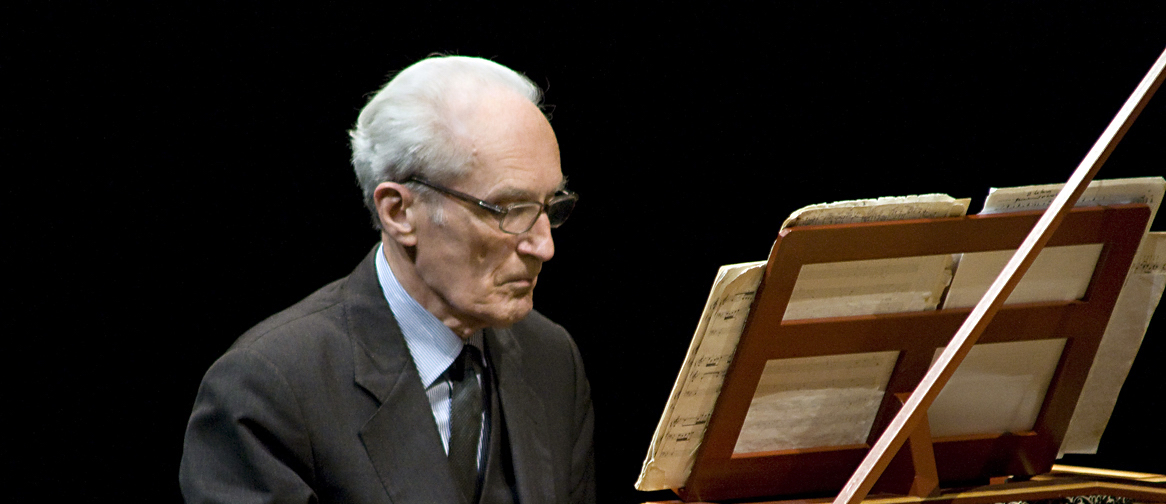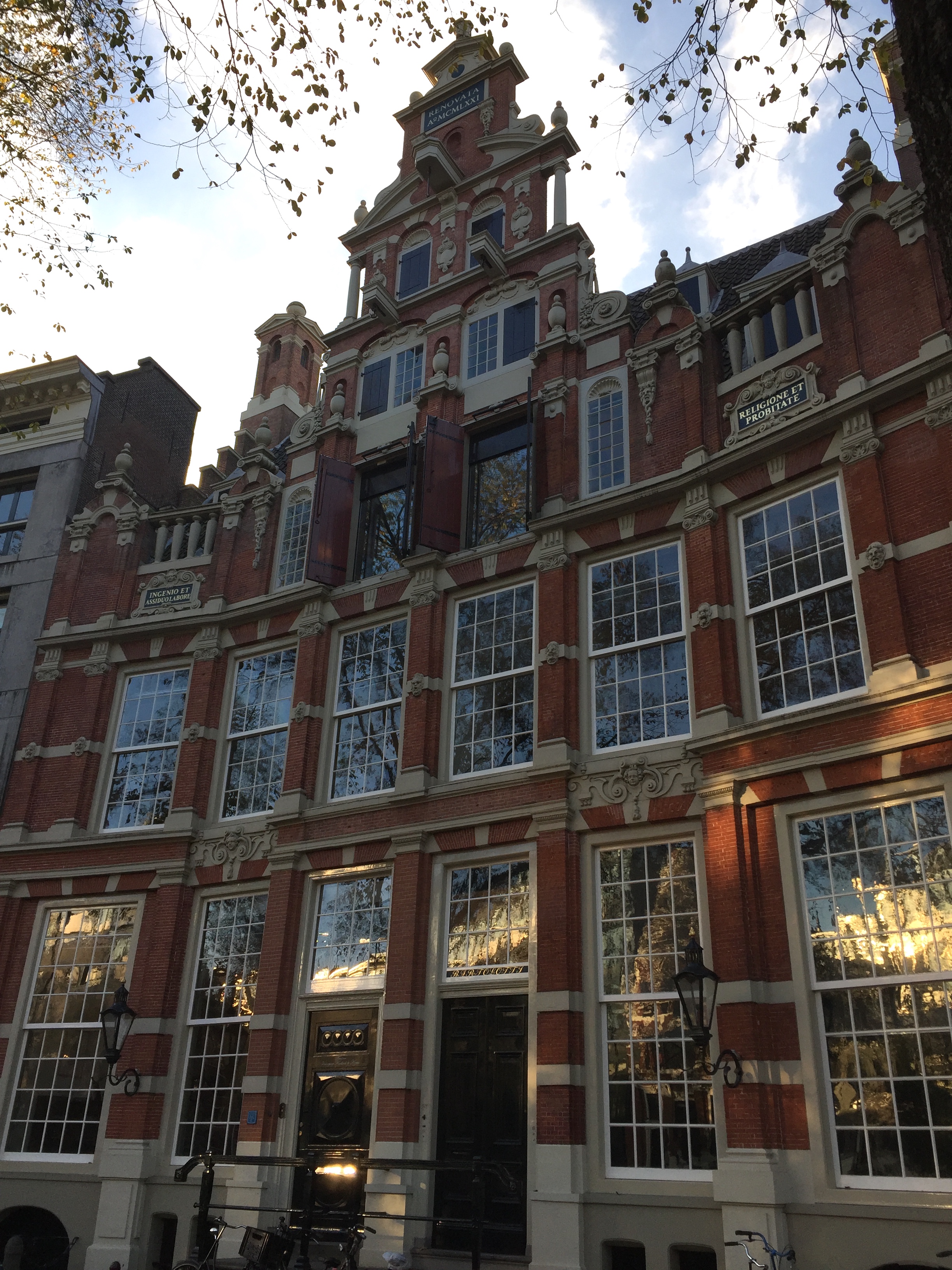


December 17, 2017
CHARLOTTE MATTAX MOERSCH
–––––––––––––––––––––––––––
Recollections of My Lessons with Gustav Leonhardt

December 17, 2017
CHARLOTTE MATTAX MOERSCH
–––––––––––––––––––––––––––
Recollections of My Lessons with Gustav Leonhardt

Introduction
Charlotte Mattax Moersch, Professor of Harpsichord at the University of Illinois, recalls her lessons as a Fulbright Scholar studying with the eminent Dutch harpsichordist Gustav Leonhardt.
––––––––––––––––––––––––

I lingered outside the Huis Bartolotti at 170 Herengracht, taking in the magnificence of the ornate façade, with its flamboyant step gable, marble obelisk, and scrollwork. Designed in 1617 by Hendrick de Keyser, the architect who also built the nearby Westerkerk, this house was not just a star on my tourist’s map of Amsterdam, but was to play a central role in my life for the next eight months. Gustav Leonhardt greeted me with his customary reserve, but with a warm smile that immediately put me at ease. Like many young harpsichordists, I had met him at the Bruges harpsichord competition three years earlier. I followed him down the marble floored hallway and into the Zaal where we had our lessons. I was awestruck by the room, which was decorated with Baroque art, furniture, and porcelain from Leonhardt’s own collection — an inspiring backdrop for Frescobaldi, Bach, and Byrd, whose pieces I had brought to play for him that afternoon.

After a few perfunctory pleasantries, Leonhardt ushered me to the harpsichord. He folded himself into a chair on the opposite wall a little behind the harpsichord, crossed his arms, and we began. The procedure was the same for all of my lessons. I played, he listened intently (never with a score), and then he sat down at the instrument and demonstrated. Although this may have produced a few students who imitated him over the years, copying was never his goal.
He taught by example, showing his solutions and revealing what he called “professional secrets.” What became clear to me over the next few months was that he was sharing with me, always in great detail, his understanding of the language and style of a piece, as well as techniques for bringing these out in performance, above all, techniques which made the harpsichord expressive. Yet, he was not dogmatic, and encouraged me to bring my own ideas and imagination to the lessons.
After each lesson, which lasted several hours, I hurried back to my apartment and wrote down what I could remember, both in the score itself, and in a notebook. I had the good fortune to live two doors down from the Bartolotti House in an apartment on the third floor of a beautiful seventeenth-century merchant’s house at Herengracht 164. The recollections that follow are based on some of the notes in my journal from my time as a young harpsichord student nearly 35 years ago. Leonhardt’s words are in quotation marks.
Journal Entry, September 3, 1983
Girolamo Frescobaldi: Toccata Nona from Book II
The opening should be free, and should sound as if “from a distance.” Let it come out without planning, with more fantasy, he instructs. Leonhardt illustrates this with his elegant hands going off in this direction and that, as if gesturing to the heavens for inspiration, or so it seemed to me at the time. Perhaps he was merely pointing to the beautiful ceiling of the room, which was adorned with a painting by the seventeenth-century artist Jacob de Wit.
Later in the piece, Frescobaldi introduces figura corta motifs. Some should sound “fast and wild,” and the others a “bit whimsical” as they follow after each other in imitation. Leonhardt’s eyes sparkle as he explains this, mirroring the playfulness of these figures as they are tossed from one voice to the next.
On the question of whether to assimilate duple into triple meters in the toccata, Leonhardt (at least at the time) believes in a literal rendition. The clash of two against three and, in one section, three against four, is “unnatural,” he muses, but to him this is the point. These sections should sound “bizarre.”
J.S. Bach: Prelude and Fugue in F-Sharp Major, BWV 882, Well-Tempered Clavier, Book II
Quietly, as if to embody his concept, Leonhardt nearly whispers: “We should hear from the first notes of a piece what the “sound” [affect] of the piece will be. To accomplish this, he says, start out tentatively, somewhat slowly, as if it is difficult to begin. The second statement in measure two should also be “slow” and “difficult,” but for the third statement in the next measure — the conclusive statement — the tempo should be faster and the playing more decisive.
Leonhardt turns to grin at me somewhat slyly. Let me show you a “professional trick,” I recall his having said. He demonstrates how to hold over notes to keep the sound alive. He then proceeds to go over in great detail how one note might just barely be articulated in the right hand while the left hand plays over-legato to keep the harmony going and to avoid stress on the weak beats. The rule of thumb, he reiterates, is to articulate only the important notes, since over-articulation makes the harpsichord sound empty.
He carries this idea over to the fugue, making the passing tones legato. I had been playing the last two quarter notes of the first full bar of the theme short, like in a gavotte. Leonhardt did the opposite, making these two notes over legato. In a final point about the subject of the fugue, Leonhardt again gestures upward during the quarter rest on the second beat. Wait longer than the actual time value of the rest for emphasis, he explains, his hands themselves ask a rhetorical question mark as they pause midair.
William Byrd: Walsingham Variations
Leonhardt is emphatic: There is only one strong beat in the theme, “Will you go to Wal´singham,” which is on the half note underlying the syllable “Wal.” Bring this out throughout the piece. Further, “weak notes won’t be successfully weak if strong notes are not strong enough.” This was to be a theme throughout our lessons, that is, the distinction between strong and weak notes. To make notes stronger here, one can sometimes add notes to the left hand and then immediately release them (as for example in the penultimate bar of the sixth variation). By contrast, to weaken unstressed chords, arpeggiate slightly before releasing them.
With a degree of insouciance, as if to demonstrate his meaning, Leonhardt shares another recurring idea: Within the definite beat framework of three half notes, the eighth notes can be treated freely, “whimsically,” “not predictably even.” Leonhardt frequently used terms like wit or whimsy. A performance, while perfect, could be bland and thus disappointing in Leonhardt’s view.
General Conclusion
As we concluded this first lesson, I came away with three general thoughts:
1. Details are important, but only as subservient to the larger gestural level.
2. Not everything should be planned.
3. Pay less attention to playing the harpsichord and more attention to making music.
Leonhardt’s genius as a pedagogue lay in his ability to assess my playing, determine what I needed to improve it, and communicate these ideas to me nonverbally, always with kindness, respect, and dignity.
––––––––––––––––––––––––
Since capturing First and Third Prizes at the International Harpsichord Competitions in Paris and Bruges in both solo harpsichord and basso continuo performance,
The recipient of several important awards and prizes, she was honored with a Solo Recitalist Grant from the National Endowment for the Arts and a Woolley Scholarship for study in Paris. A specialist in seventeenth-century French music, she is the author of the book, Accompaniment on Theorbo and Harpsichord: Denis Delair’s Traité of 1690, published by Indiana University Press. She has recorded for Centaur, Koch, Analekta, Dorian, Newport Classic, and Amon Ra Records. Solo harpsichord discs include toccatas and partitas of J.S. Bach, the sonatas of W.F. Bach, and the Piéces de clavecin of Jean-Henry D’Anglebert, Armand-Louis Couperin, Charles Noblet, and Pierre Février. Upcoming recording projects feature the sonatas of W.C.F. Bach.
Currently Professor of Harpsichord at the University of Illinois, where she directs the period instrument ensemble Concerto Urbano, Charlotte Mattax Moersch studied harpsichord with Gustav Leonhardt at the Sweelinck Conservatory, Bob van Asperen at the Hague Conservatory, and Kenneth Gilbert in Paris, where she also studied organ with André Isoir. She has degrees from Yale University, the Juilliard School of Music, and Stanford University.
The views and opinions expressed in this article are those of the author, and do not necessarily reflect the position of Vox Humana.